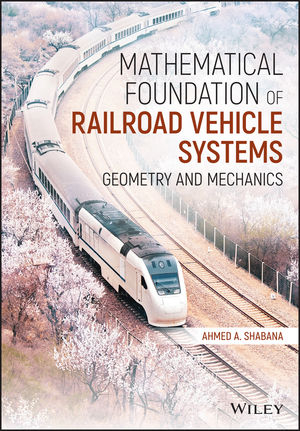
Mathematical Foundation of Railroad Vehicle Systems
Wiley (Verlag)
978-1-119-68904-1 (ISBN)
AHMED A. SHABANA is University Distinguished Professor and the Richard and Loan Hill Professor of Engineering at the University of Illinois at Chicago, United States. He is a Fellow of the American Society of Mechanical Engineers (ASME), a Fellow of the Society of Automotive Engineering (SAE International), and the author of texts in the areas of dynamics and vibration.
Preface
Chapter 1 Introduction
1.1 Differential Geometry
1.2 Integration of Geometry and Mechanics
1.3 Hunting Oscillations
1.4 Wheel and Track Geometries
1.5 Centrifugal Forces and Balance Speed
1.6 Contact Formulations
1.7 Computational MBS Approaches
1.8 Derailment Criteria
1.9 High-Speed Rail Systems
1.10 Linear Algebra and Book Notations
Chapter 2 Differential Geometry
2.1 Curve Geometry
2.2 Surface Geometry
2.3 Application to Railroad Geometry
2.4 Surface Tangent Plane and Normal Vector
2.5 Surface Fundamental Forms
2.6 Normal Curvature
2.7 Principal Curvatures and Directions
2.8 Numerical Representation of the Profile Geometry
2.9 Numerical Representation of the Surface Geometry
Chapter 3 Motion and Geometry Description
3.1 Rigid Body Kinematics
3.2 Direction Cosines and Simple Rotations
3.3 Euler Angles
3.4 Euler Parameters
3.5 Velocity and Acceleration Equations
3.6 Generalized Coordinates
3.7 Kinematic Singularities
3.8 Euler Angles and Track Geometry
3.9 Angle Representation of the Curve Geometry
3.10 Euler Angles as Field Variables
3.11 Euler-Angle Description of the Track Geometry
3.12 Geometric Motion Constraints
3.13 Trajectory Coordinates
Chapter 4 Railroad Geometry
4.1 Wheel Surface Geometry
4.2 Wheel Curvatures and Global Vectors
4.3 Semi-Analytical Approach for Rail Geometry
4.4 ANCF Rail Geometry
4.5 ANCF Interpolation of the Rail Geometry
4.6 ANCF Computation of the Tangents and Normal
4.7 Track Geometry Equations
4.8 Numerical Representation of the Track Geometry
4.9 Track Data
4.10 Irregularities and Measured Track Data
4.11 Comparison of the Semi-Analytical and ANCF Approaches
Chapter 5 Contact Problem
5.1 Wheel/Rail Contact Mechanism
5.2 Constraint Contact Formulation (CCF)
5.3 Elastic Contact Formulation (ECF)
5.4 Normal Contact Forces
5.5 Contact Surface Geometry
5.6 Contact Ellipse and Normal Contact Force
5.7 Creepage Definitions
5.8 Creep Force Formulations
5.9 Creep Force and Wheel/Rail Contact Formulations
5.10 Maglev Forces
Chapter 6 Equations of Motion
6.1 Newtonian and Lagrangian Approaches
6.2 Virtual Work Principle and Constrained Dynamics
6.3 Summary of the Rigid Body Kinematics
6.4 Inertia Forces
6.5 Applied Forces
6.6 Newton-Euler Equations
6.7 Augmented Formulation and Embedding Technique
6.8 Wheel/Rail Constraint Contact Forces
6.9 Wheel/Rail Elastic Contact Forces
6.10 Other Force Elements
6.11 Trajectory Coordinates
6.12 Longitudinal Train Dynamics (LTD)
6.13 Hunting Stability
6.14 MBS Modeling of Electro-Mechanical Systems
Chapter 7 Pantograph/Catenary Systems
7.1 Pantograph/Catenary Design
7.2 ANCF Catenary Kinematic Equations
7.3 Catenary Inertia and Elastic Forces
7.4 Catenary Equations of Motion
7.5 Pantograph/Catenary Contact Frame
7.6 Constraint Contact Formulation (CCF)
7.7 Elastic Contact Formulation (ECF)
7.8 Pantograph/Catenary Equations and MBS Algorithm
7.9 Pantograph/Catenary Contact Force Control
7.10 Aerodynamic Forces
7.11 Pantograph/Catenary Wear
Appendix A Contact Equations and elliptical integrals
A.1 Derivation of the Contact Equations
A.2 Elliptical Integrals
References
Index
| Erscheinungsdatum | 24.02.2021 |
|---|---|
| Verlagsort | Hoboken |
| Sprache | englisch |
| Maße | 170 x 244 mm |
| Gewicht | 806 g |
| Themenwelt | Technik ► Bauwesen |
| Technik ► Elektrotechnik / Energietechnik | |
| Technik ► Maschinenbau | |
| ISBN-10 | 1-119-68904-X / 111968904X |
| ISBN-13 | 978-1-119-68904-1 / 9781119689041 |
| Zustand | Neuware |
| Haben Sie eine Frage zum Produkt? |
aus dem Bereich


